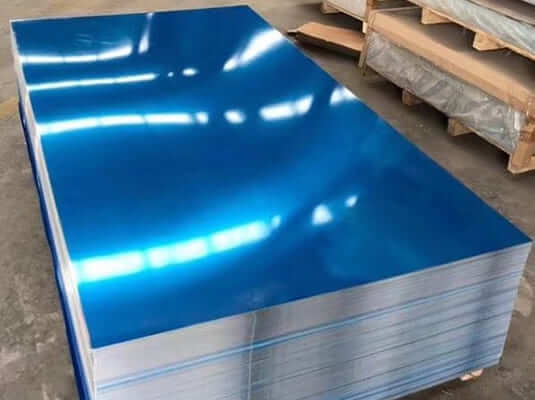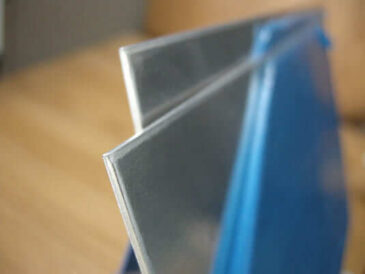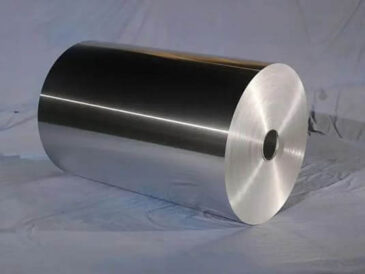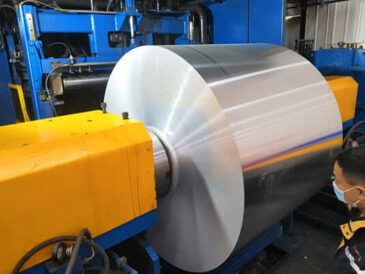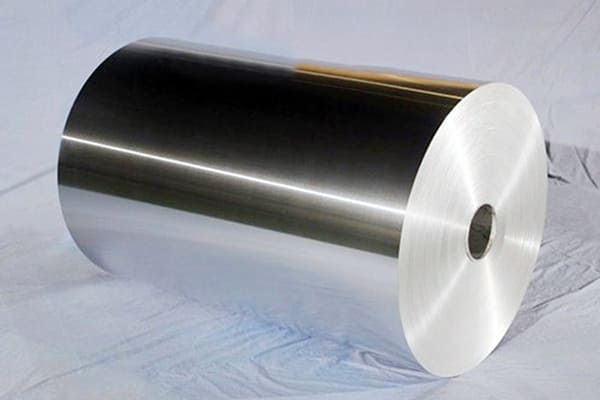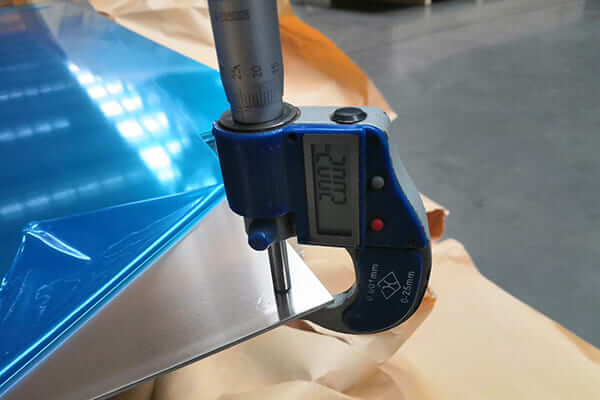Introduction to 7075 aluminum alloy
7075 aluminum alloy is a representative product of the 7000 series aluminum alloy. It mainly contains zinc elements. It also belongs to the aviation series. It is an aluminum-magnesium-zinc-copper alloy. It is a heat-treatable alloy. It is a superhard aluminum alloy and is the strongest aluminum alloy among common aluminum alloys. Has good wear resistance.
7000 series aluminum alloy metal Al-Zn-Mg-Cu series superhard aluminum. 7000 series aluminum alloy contains zinc and magnesium elements. Zinc is the main alloying element in this series, so its corrosion resistance is quite good. Adding a little magnesium alloy allows the material to achieve very high strength after heat treatment.

7075 aluminum alloy
This alloy is an ultra-high-strength deformed aluminum alloy that has been used in the aircraft manufacturing industry in the late 1940s and is still widely used in the aviation industry. Its characteristics are: good plasticity after solution treatment, particularly good heat treatment strengthening effect, high strength below 150℃, and particularly good low-temperature strength; poor welding performance; tendency to stress corrosion cracking; requires aluminum cladding or other Protective handling used.
Dual-stage aging can improve the alloy’s ability to resist stress corrosion cracking. The plasticity in the annealed and freshly quenched states is slightly lower than that of 2A12 in the same state, and slightly better than that of 7A04. The plate’s static fatigue notch is sensitive, and its stress corrosion performance is better than that of 7A04. Density is 2.85g/cm3.
7075 aluminum chemical composition
| – | Chemical composition | Other | – | ||||||||
| Alloy | Si | Fe | Cu | Mn | Mg | Cr | Zn | Ti | Other | Total | Al |
| 7075 | ≤0.4 | ≤0.5 | 1.2-2.0 | ≤0.3 | 2.1-2.9 | 0.18-0.28 | 5.1-6.1 | ≤0.2 | 0.05 | 0.15 | Remainder |
Zinc is the main alloying element in 7075 aluminum alloy. Adding magnesium to an alloy containing 3%-7.5% zinc can form MgZn2 with significant strengthening effect, making the heat treatment effect of this alloy far better than that of aluminum-zinc binary alloy. Increasing the zinc and magnesium content in the alloy will further increase the tensile strength, but its ability to resist stress corrosion and spalling corrosion will decrease.
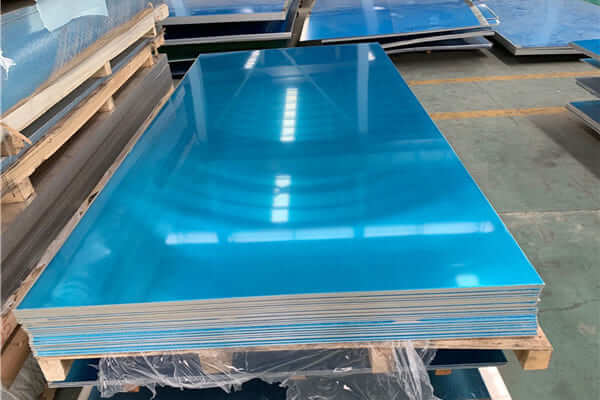
7075 aluminum sheet plate
After being heat treated, it can achieve very high strength properties. 7075 aluminum alloy materials generally add a small amount of copper, chromium and other alloys. Among this series, 7075-T651 alloy is particularly top-grade and is known as the best product among aluminum alloys. It has high strength and Far superior to any mild steel. This alloy has good mechanical properties and anodic reaction. Its typical uses include aerospace, mold processing, mechanical equipment, and tooling fixtures. It is especially used in the manufacture of aircraft structures and high-stress structures that require high strength and strong corrosion resistance.
7075 aluminum alloy features
- 1. High strength heat treatable alloy.
- 2. Good mechanical properties.
- 3. Good usability.
- 4. Easy to process and good wear resistance.
- 5. T7351 temper enhances corrosion and fracture resistance
- 6. High-strength materials for high-pressure structural parts.
7075 aluminum alloy is a cold-processed forged aluminum alloy that has higher strength than ordinary steel.
7075 is a cold-treated forged aluminum alloy that has higher strength than ordinary steel. 7075 is one of the very strong aluminum alloys used in commercial applications. 7075 aluminum alloy has a compact structure and strong corrosion resistance, and is especially suitable for aviation and marine plates. It has general corrosion resistance, good mechanical properties and anodic reaction. Fine grains enable better deep hole drilling performance and improved tool wear resistance.
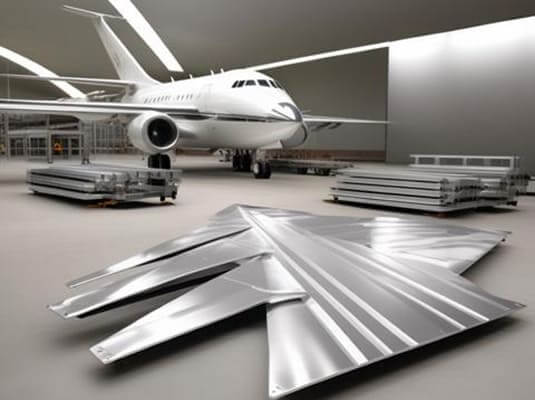
Airplane by 7075 aluminum alloy
7075 aluminum alloy in different states
F Free processing state is suitable for products with no special requirements for work hardening and heat treatment conditions during the molding process. The mechanical properties of the products in this state are not specified.
O Annealed state is suitable for processed products that have been completely annealed to obtain the lowest strength.
H Work hardening state is suitable for products whose strength is increased through work hardening. After work hardening, the product may or may not undergo additional heat treatment that reduces the strength.
W Solid solution heat treatment state Treatment state is an unstable state that is only applicable to alloys that have been naturally aged at room temperature after solid solution heat treatment. This state code only indicates that the product is in the natural aging stage.
T heat treatment state (different from F, O, H state) is suitable for products that have been stabilized through (or not through) work hardening after heat treatment. The T code must be followed by one or more Arabic numerals. The first digit after the T indicates the basic type of heat treatment (from 1 to 10), and subsequent digits indicate changes in heat treatment details. Such as 6061-T 62; 5083-H 343, etc.
T1—cooled from the molding temperature and aged naturally to a generally stable state.
T2—annealed state (only for castings).
T3—Natural aging after solid solution treatment and cold working.
T31—Natural aging after solid solution treatment and cold working (1%).
T36—Natural aging after solid solution treatment and cold working (6%).
T37—natural aging after solid solution treatment and cold working (7%), used for 2219 alloy.
T4—Natural aging after solution treatment. T41—boiling water quenching after solid solution treatment.
T411—air cooled to room temperature after solution treatment, hardness between O and T6, low residual stress.
T42—natural aging after solution treatment. Processed by the user, suitable for 2024 alloy, slightly lower strength than T4.
T5—Artificial aging after cooling from molding temperature.
T6—Artificial aging after solution treatment.
T61—T41+artificial aging.
T611—solid solution treatment, boiling water quenching.
T62—Artificial aging after solution treatment.
T7—Stabilized after solution treatment. Improve dimensional stability, reduce residual stress, and improve corrosion resistance.
T72—Overaging after solution treatment.
T73—Graded aging after solid solution treatment, the strength is lower than T6, and the corrosion resistance is significantly improved.
T76—Graded aging after solution treatment.
T8—Artificial aging after solution treatment and cold work.
T81—cold work after solution treatment and artificial aging. In order to improve the deformation and strength after solution treatment.
T86—Solution treatment followed by cold work (6%), artificial aging.
T87—T37+artificial aging.
T9—Artificial aging after solution treatment and then cold working.
T10—cooling from molding temperature, cold working after artificial aging.
Tx51—stretching treatment to eliminate residual stress after solution treatment. The permanent deformation of plates is 0.5~3%, and the permanent deformation of rods and profiles is 1~3%. X represents 3, 4, 6 or 8, such as T351, T451, T651, T851. It is suitable for plates, drawn rods and wires. It is aged without any correction after stretching to relieve stress. T3510, T4510, and T8510 are suitable for extruded profiles. After stretching to relieve stress, they are corrected to make the flatness meet the tolerance and aged.
Tx52—Compression deformation is performed to eliminate the residual stress after solution treatment. After solution treatment, 2.5% plastic deformation is performed and then aged, such as T352 and T652.
Tx53—Thermal stress relief.
Tx54—Compression deformation is performed to eliminate residual stress after solution treatment of precision forgings.
Common heat treatment tempers of 7075 aluminum alloy
- 1. Natural aging: When 7075 aluminum alloy undergoes natural aging treatment, the alloy material is kept at room temperature for a period of time so that it gradually hardens under natural conditions. The 7075 aluminum alloy in this processed state has lower strength and hardness, but retains higher toughness.
- 2. Artificial aging: 7075 aluminum alloy is usually artificially aged to obtain optimal strength and hardness. In this process, the alloy material first undergoes solution treatment, that is, it is rapidly heated at high temperature and held for a period of time to dissolve the alloy elements in the solid solution into the matrix. The material is then rapidly cooled and subsequently aged at the appropriate temperature to encourage the alloying elements to form dispersed fine precipitates. These precipitates can increase the strength and hardness of 7075 aluminum alloy.
- 3. T6 heat treatment: 7075 aluminum alloy can obtain the highest strength and hardness after T6 heat treatment state. Including solid solution treatment and artificial aging treatment. In solution treatment, the 7075 aluminum alloy is heated to about 495°C to 505°C, held for a period of time to allow the alloy elements to be evenly dissolved in the matrix, and then cooled rapidly. Subsequently, the material undergoes artificial aging treatment and is maintained at a temperature of approximately 120°C to 180°C for a period of time, allowing the alloying elements to form fine dispersed precipitates, further improving the strength of the material.
7075 aluminum alloy mechanical properties
Typical Mechanical Properties of 7075 Aluminum
| ALLOY AND TEMPER | Ultimate TensileStrength(250℃MPa) | Yield TensileStrength(250℃MPa) | Hardness(1/16in) | Elongation |
| 7075-T651 | 520 | 480 | 160 | 10 |
7075 Aluminum Typical Physical Properties
| ALLOY ANDTEMPER | Average Coefficient OfThermal Expansion(20-100℃)um/m.k | Melting Range(℃) | Electrical Conductivity(68°F) | ElectricalResistivity(68°F) |
| 7075-T651 | 23.6 | 475-635 | 33 | 0.0515 |
The 7000 series aluminum alloy belongs to the superhard aluminum of the Al-Zn-Mg-Cu series.
7075-T651 aluminum alloy is particularly excellent and is known as the best aluminum alloy product. It has high strength, far superior to any ordinary steel. This alloy also has good mechanical properties and anodic reaction. Typical applications include aerospace, mold processing, mechanical equipment, and tooling fixtures. It is especially suitable for manufacturing aircraft structures and other high-stress structures that require high strength and strong corrosion resistance.
Standards in different countries
- National standard: 7075 GB/T3190–2008
- Japanese standard: A7075 JIS H4000-1999 JIS H4080-1999
- Non-standard: 76528 IS 733-2001 IS737-2001
- Russian standard: B95/1950 rocT 4785-1974
- EN:EN AW-7075/AlZn5.5MgCu EN573-3-1994
- German standard: AlZnMgCu1.5/3.4365 DIN172.1-1986/w-nr
- French standard: 7075 (A-Z5GU) NFA50-411 NFA50-451
- British Standard: 7075 (C77S) BS 1470-1988
- American Standard: 7075/A97075 AA/UNS
Applications of 7075 aluminum alloy
Aerospace: 7075 aluminum alloy is widely used in manufacturing key components such as aircraft fuselages, wings, and landing gears. Due to its high strength and lightweight characteristics, the use of 7075 aluminum alloy can greatly reduce the weight of the aircraft and improve flight performance and fuel economy.

7075 aluminum for wing
Military applications: 7075 aluminum alloy is used to manufacture tank armor, warship shells, missile launchers and other weapons and equipment. Its excellent impact resistance and corrosion resistance can improve the combat effectiveness and service life of weapons and equipment.
Automotive applications: 7075 aluminum alloy is used to manufacture automobile bodies, chassis, engines and other parts. By using 7075 aluminum alloy, automakers can reduce body weight, improve fuel economy and vehicle handling performance
Sports equipment: 7075 aluminum alloy is commonly used to manufacture sports equipment such as mountaineering equipment, bicycle structures, high-quality fishing rods, and high-performance skis. Its lightweight and high strength provide superior performance and durability.
Industrial applications: 7075 aluminum alloy is also widely used in various industrial applications, including mold manufacturing, shipbuilding, chemical equipment, and food processing equipment. Its corrosion resistance and wear resistance allow 7075 aluminum alloy to work in harsh environments for a long time.
The difference between 7075 and 6061 aluminum alloy
7075 and 6061 aluminum alloys are two common aluminum alloy materials that are widely used in aerospace, automobile manufacturing, electronic products and other fields. Although they are similar in name, there are major differences in composition, performance, application fields, etc.
Differences in ingredients
7075 aluminum alloy: 7075 aluminum alloy is a high-strength, high-toughness aluminum alloy whose main components include zinc, magnesium, copper, silicon and other elements. It belongs to the 7 series aluminum alloy and has good welding performance and corrosion resistance.
6061 aluminum alloy: 6061 aluminum alloy is a medium-strength, high-toughness aluminum alloy whose main components include silicon, magnesium, copper, manganese and other elements. It belongs to the 6 series aluminum alloy and has good formability and corrosion resistance.
Performance difference
- 1. Mechanical properties: The mechanical properties of 7075 aluminum alloy are better than those of 6061 aluminum alloy. It has higher tensile strength, yield strength and wear resistance, which makes 7075 aluminum alloy suitable for occasions with higher load and higher stress intensity.
- 2. Corrosion resistance: Both 7075 aluminum alloy and 6061 aluminum alloy have good corrosion resistance, but 7075 aluminum alloy performs better in corrosive environments such as seawater.
- 3. Welding performance: The welding performance of 7075 aluminum alloy is better than that of 6061 aluminum alloy, and it is suitable for the design of welded structures.
- 4. Forming performance: 6061 aluminum alloy has good formability and is suitable for processing and forming of complex shapes.
Prices are different
7075 is the lightest and strongest aluminum material, and is also more expensive, while 6061 is the most common aluminum material, light, strong, and economical.
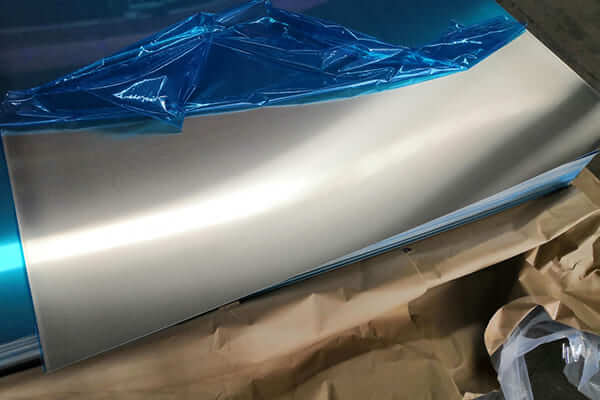
6061 aluminum alloy sheet
Differences in application fields
1. 7075 aluminum alloy: Due to its excellent mechanical properties and welding properties, 7075 aluminum alloy is widely used in aerospace, automobile manufacturing, shipbuilding industry, electronic products and other fields.
2. 6061 aluminum alloy: Due to its good formability and corrosion resistance, 6061 aluminum alloy is widely used in building doors and windows, curtain walls, furniture, sports equipment and other fields.
What can we supply?
Huawei Aluminum has been focusing on the production and sales of aluminum products for 22 years. Our characteristics are product quality and service. The products we can provide include:
- Aluminum sheet plates (mill finish, embossed plates, mirror plates, color-coated aluminum plates, punched aluminum plates, anodized aluminum plates, roof tiles, etc.)
- Aluminum coil (mill finish, color-coated aluminum coil, embossed aluminum coil)
- Aluminum strip
- Aluminum circle discs (color-coated aluminum discs, punched aluminum discs)
- Aluminum foil (light foil, various composite aluminum foil)
What we can do is not only ensure product quality and delivery date, we can also provide you with high-quality services. High-quality purchasing experience and after-sales service are also our characteristics.
More about 7075 aluminum please visit:https://hw-alu.com/products/7075-aluminum-sheet-plate.html
Casting production process and its introduction
The purpose of melting and casting is to produce alloys with satisfactory composition and high purity of melt, so as to create favorable conditions for casting alloys of various shapes.
Melting and casting process steps: batching --- feeding --- melting --- stirring after melting, slag removal --- pre-analysis sampling --- adding alloy to adjust the composition, stirring --- refining --- static Setting——Guide furnace casting.
Hot rolling production process and its introduction
- 1. Hot rolling generally refers to rolling above the metal recrystallization temperature;
- 2. During the hot rolling process, the metal has both hardening and softening processes. Due to the influence of deformation speed, as long as the recovery and recrystallization process is too late, there will be a certain work hardening;
- 3. The recrystallization of the metal after hot rolling is incomplete, that is, the coexistence of recrystallized structure and deformed structure;
- 4. Hot rolling can improve the processing performance of metals and alloys, reduce or eliminate casting defects.
- 1. The casting and rolling temperature is generally between 680°C and 700°C. The lower the better, the stable casting and rolling line usually stops once a month or more to re-stand. During the production process, it is necessary to strictly control the liquid level of the front tank to prevent low liquid level;
- 2. Lubrication uses C powder with incomplete combustion of gas for lubrication, which is also one of the reasons for the dirty surface of casting and rolling materials;
- 3. The production speed is generally between 1.5m/min-2.5m/min;
- 4. The surface quality of products produced by casting and rolling is generally relatively low, and generally cannot meet products with special physical and chemical performance requirements.
- 1. Cold rolling refers to the rolling production method below the recrystallization temperature;
- 2. There will be no dynamic recrystallization during the rolling process, and the temperature will rise to the recovery temperature at most, and the cold rolling will appear in a work hardening state, and the work hardening rate will be large;
- 3. The cold-rolled sheet and strip have high dimensional accuracy, good surface quality, uniform structure and performance, and products in various states can be obtained with heat treatment;
- 4. Cold rolling can roll out thin strips, but at the same time, it has the disadvantages of high energy consumption for deformation and many processing passes.
- 1. Finishing is a processing method to make the cold-rolled sheet meet the customer's requirements, or to facilitate the subsequent processing of the product;
- 2. The finishing equipment can correct the defects produced in the hot rolling and cold rolling production process, such as cracked edge, oily, poor plate shape, residual stress, etc. It needs to ensure that no other defects are brought into the production process;
- 3. There are various finishing equipments, mainly including cross-cutting, slitting, stretching and straightening, annealing furnace, slitter, etc.
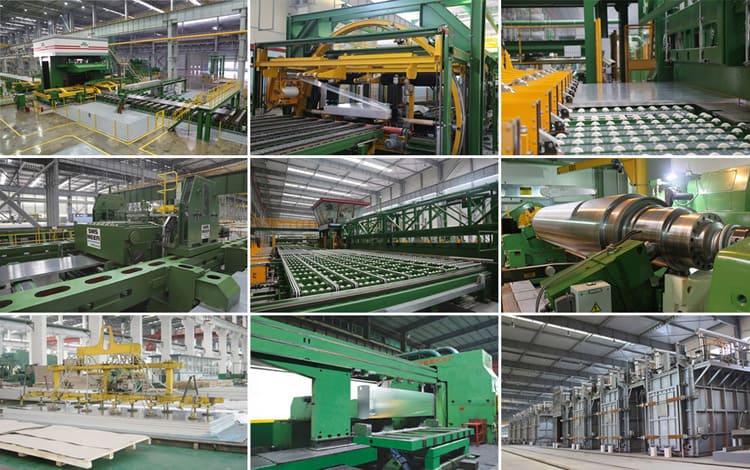
Casting and rolling process
Casting and rolling process: liquid metal, front box (liquid level control), casting and rolling machine (lubrication system, cooling water), shearing machine, coiling machine.
Cold rolling production process

Introduction to finishing production process
Aluminum alloy has the characteristics of low density, good mechanical properties, good processing performance, non-toxic, easy to recycle, excellent electrical conductivity, heat transfer and corrosion resistance, so it has a wide range of applications.
Aerospace: used to make aircraft skins, fuselage frames, girders, rotors, propellers, fuel tanks, wall panels and landing gear struts, as well as rocket forging rings, spacecraft wall panels, etc.
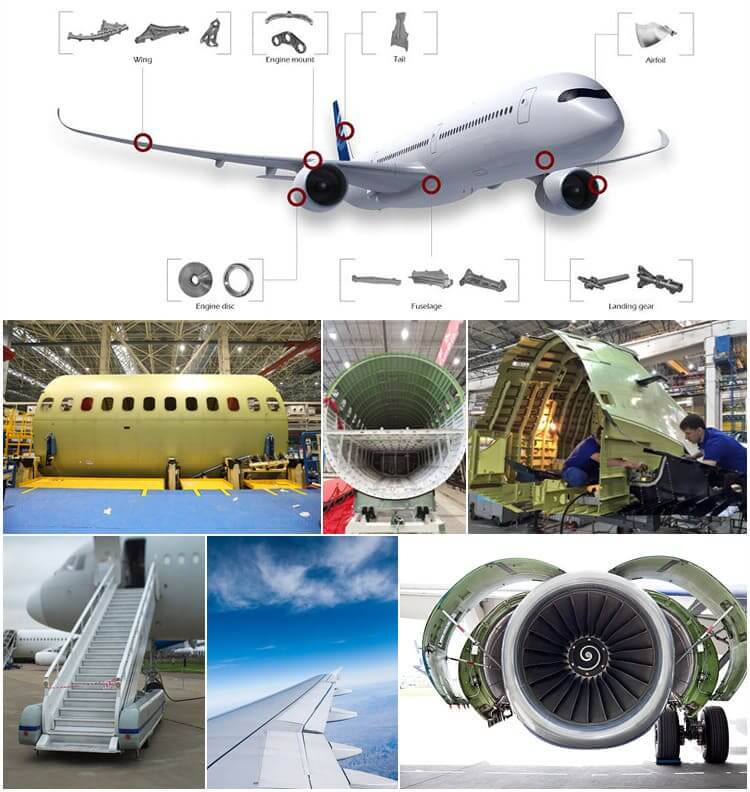
Aluminum alloy used for aerospace
Transportation: used for car body structure materials of automobiles, subway vehicles, railway passenger cars, high-speed passenger cars, doors and windows, shelves, automotive engine parts, air conditioners, radiators, body panels, wheels and ship materials.
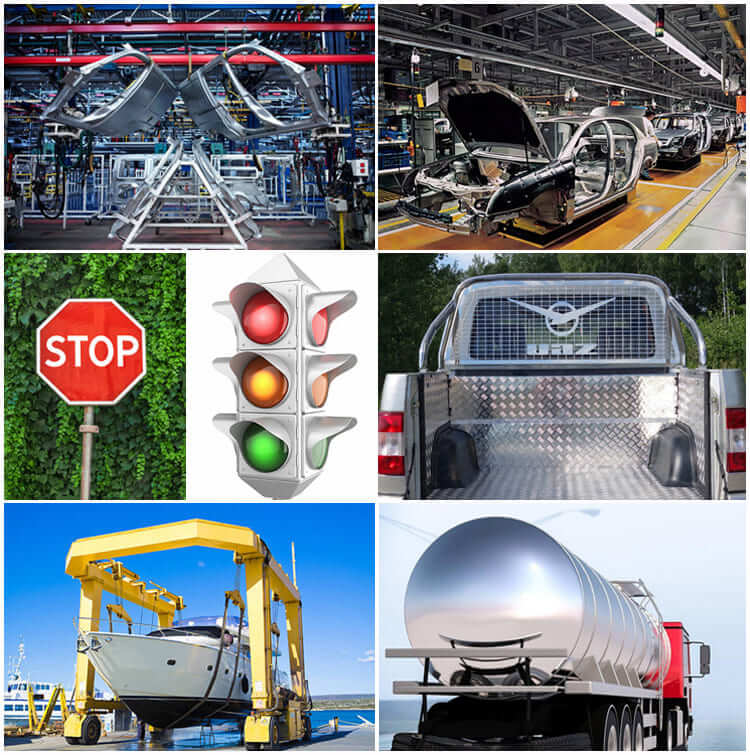
Traffic application
Packaging: All-aluminum pop cans are mainly used as metal packaging materials in the form of thin plates and foils, and are made into cans, lids, bottles, barrels, and packaging foils. Widely used in the packaging of beverages, food, cosmetics, medicines, cigarettes, industrial products, medicines, etc.
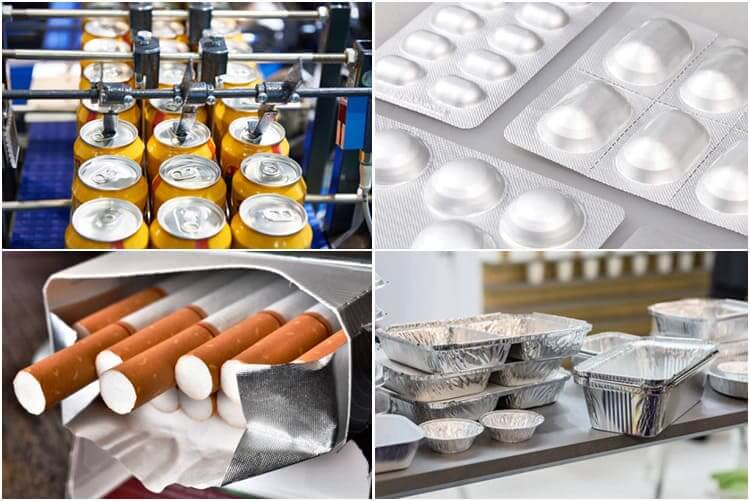
Packaging application
Printing: Mainly used to make PS plates, aluminum-based PS plates are a new type of material in the printing industry, used for automatic plate making and printing.

PS printing
Architectural decoration: aluminum alloy is widely used in building structures, doors and windows, suspended ceilings, decorative surfaces, etc. due to its good corrosion resistance, sufficient strength, excellent process performance and welding performance.
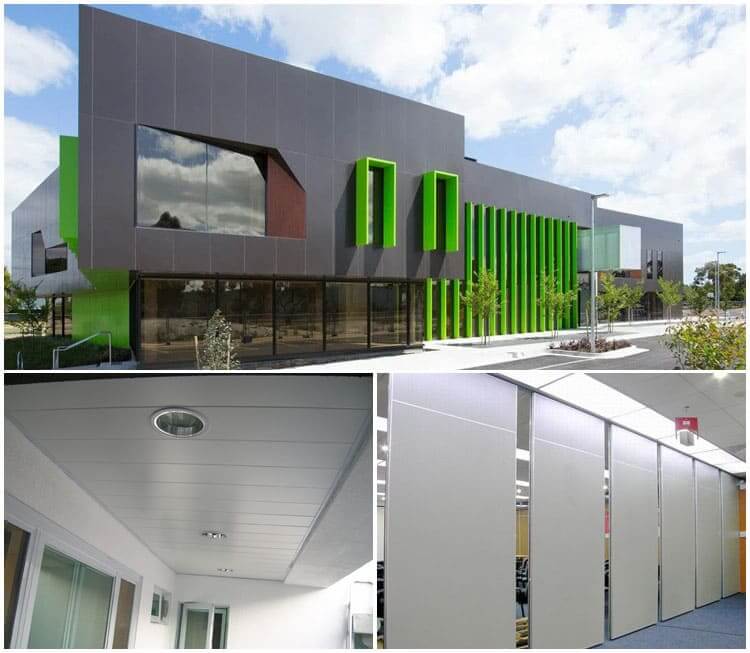
Aluminum alloy construction application
Electronic products: computers, mobile phones, refrigerator shells, radiators, etc.

Electronic product application
Kitchen supplies: aluminum pots, aluminum basins, rice cooker liners, household aluminum foil, etc.

Kitchen application
Packaging Of Aluminum Sheet/Coil
Every detail of packaging is where we pursue perfect service. Our packaging process as a whole is as follows:
Lamination: clear film, blue film, micro-mucosal, high-mucosal, laser cutting film (2 brands, Novacell and Polyphem);
Protection: paper corner protectors, anti-pressure pads;
drying: desiccant;
Tray: fumigated harmless wooden tray, reusable iron tray;
Packing: Tic-tac-toe steel belt, or PVC packing belt;
Material Quality: Completely free from defects such as white rust, oil spots, rolling marks, edge damage, bends, dents, holes, break lines, scratches, etc., no coil set.
Port: Qingdao or other ports in China.
Lead time: 15-45 days.

Aluminum sheet/plate packaging process
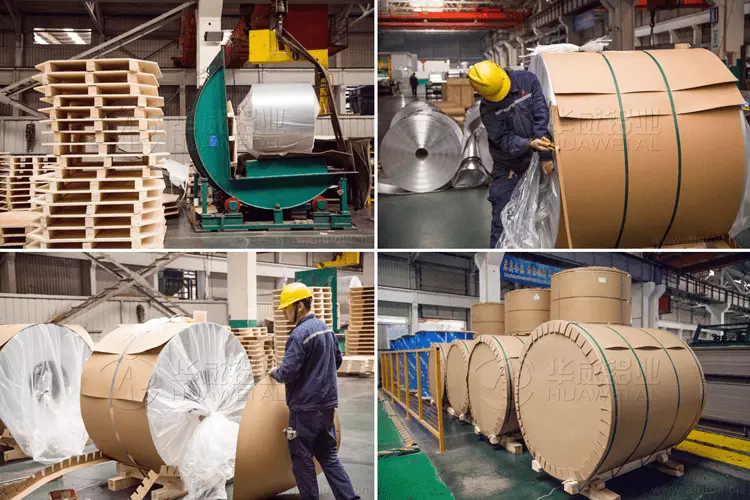
Aluminum coil packaging process
F: Are you a manufacturer or a trader?
Q: We are a manufacturer, our factory is at No.3 Weier Road, Industrial Zone, Gongyi, Henan, China.
F: What is the MOQ for ordering the product?
Q: Our MOQ is 5 tons, and some special products will have a minimum order quantity of 1 or 2 tons.
F: How long is your lead time?
Q: Generally our lead time is about 30 days.
F: Do your products have quality assurance?
Q: Yes, if there is a quality problem with our products, we will compensate the customer until they are satisfied.
Related Products
Latest Blogs
6061 vs 7075 aluminum
"6061" and "7075" are two common aluminum alloy grades, which are widely used in many industrial fields, especially in aviation, aerospace, transportation and structural manufacturing.
Aluminum Foil Used in Air Fryers
Aluminum foil is widely used in daily life, mainly due to its light weight, good ductility, moderate price, and excellent heat conduction and light-shielding properties.
Reasons why the surface of honeycomb aluminum foil cannot be bonded with the adhesive
Aluminum honeycomb panels have good performance in use. They have good strength and good impact resistance. They can be well designed in use. Therefore, they are widely used at present.
Introduction hardness of 1000-8000 series aluminum alloys
1000-8000 series basically covers all aluminum alloy series products. Different series of products have different performance and hardness.

